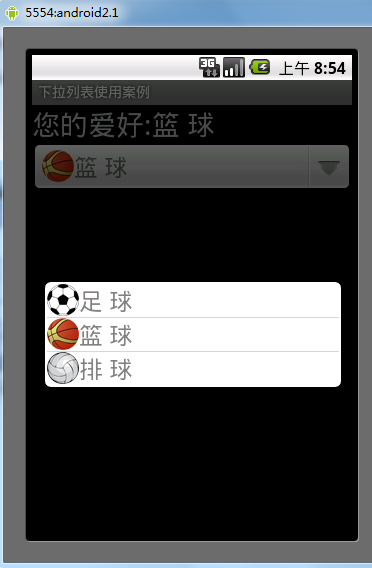
- 解决EditText、ListView以及GridView同时使用,输入法自动跳出来的方法
- Android项目实战之仿网易新闻的页面(RecyclerView )
- Android TreeView效果实现方法(附demo源码下载)
- android的消息处理机制(图文+源码分析)—Looper/Handler/Message
- 解析Android中Animation动画的编写要点
- Android入门之AlertDialog用法实例分析
- Android6.0来电号码与电话薄联系人进行匹配
- android GridView多选效果的实例代码
- Android入门之Activity四种启动模式(standard、singleTop、singleTask、singleInstance)
- Android实现退出时关闭所有Activity的方法
- android双缓冲技术实例详解
- Android图片三级缓存策略(网络、本地、内存缓存)
- Android客户端post请求服务器端实例
- Android开发技巧之永不关闭的Toast信息框(长时间显示而非系统关闭)
- Android ViewPager实现选项卡切换
- android编程开发之全屏和退出全屏的实现方法
- android sdk安装及开发环境部署
- Android开发 -- setTag的妙用和The key must be an application-specific resource id 异常
- Android编程实现3D旋转效果实例
- Android实战打飞机游戏之实现主角以及主角相关元素(3)
- anroid开发教程之spinner下拉列表的使用示例
- 浅析Android中的visibility属性
- Android自定义控件样式实例详解
- Android中自定义View实现圆环等待及相关的音量调节效果
- Android实现图片轮播效果的两种方法
- Android开发入门之Service用法分析
- 解析android中系统日期时间的获取
- [Android开发视频教学]01_29_代码编写(一)下
- Android实现滑动加载数据的方法
- Android 路径查询具体实现
Android控件之Spinner用法实例分析
作者:佚名 Android开发编辑:admin 更新时间:2022-07-23
本文实例讲述了Android控件之Spinner用法。分享给大家供大家参考。具体如下:
以下模拟下拉列表的用法
布局文件:
<?xml version="1.0" encoding="utf-8"?> <LinearLayout android:id="@+id/LinearLayout01" android:layout_width="fill_parent" android:layout_height="fill_parent" android:orientation="vertical" xmlns:android="http://schemas.android.com/apk/res/android"> <TextView android:text="@string/ys" android:id="@+id/TextView01" android:layout_width="fill_parent" android:layout_height="wrap_content" android:textSize="28dip" /> <Spinner android:id="@+id/Spinner01" android:layout_width="fill_parent" android:layout_height="wrap_content" /> </LinearLayout>
SpinnerActivity类:
package com.ljq.sp;
import android.app.Activity;
import android.os.Bundle;
import android.util.Log;
import android.view.View;
import android.view.ViewGroup;
import android.widget.AdapterView;
import android.widget.BaseAdapter;
import android.widget.ImageView;
import android.widget.LinearLayout;
import android.widget.Spinner;
import android.widget.TextView;
import android.widget.AdapterView.OnItemSelectedListener;
public class SpinnerActivity extends Activity {
private Spinner sp = null;//下拉列表
private TextView tv = null;
// 所有资源图片的数组
private int[] drawableIds={R.drawable.football,R.drawable.basketball,R.drawable.volleyball};
// 所有字符串的数组
private int[] msgIds={R.string.zq,R.string.lq,R.string.pq};
@Override
public void onCreate(Bundle savedInstanceState) {
super.onCreate(savedInstanceState);
setContentView(R.layout.main);
tv = (TextView) findViewById(R.id.TextView01);
sp=(Spinner)this.findViewById(R.id.Spinner01);//初始化Spinner
sp.setAdapter(adapter);
sp.setOnItemSelectedListener(new OnItemSelectedListener() {
public void onItemSelected(AdapterView<?> parent, View view, int positon, long id) {
LinearLayout ll = (LinearLayout) view;
View v=ll.getChildAt(0);//获取第一个控件ImageView
Log.i("ljq", v.getClass().getName());
TextView tvn = (TextView) ll.getChildAt(1);//获取第二个控件TextView
StringBuilder sb = new StringBuilder();
sb.append(getResources().getText(R.string.ys)).append(":").append(tvn.getText());
tv.setText(sb.toString());
}
public void onNothingSelected(AdapterView<?> parent) {
}
});
}
private BaseAdapter adapter = new BaseAdapter(){
public int getCount() {
return drawableIds.length;
}
public Object getItem(int position) {
return drawableIds[position];
}
public long getItemId(int position) {
return position;
}
public View getView(int position, View convertView, ViewGroup parent) {
LinearLayout ll = new LinearLayout(SpinnerActivity.this);
ll.setOrientation(LinearLayout.HORIZONTAL);
ImageView iv = new ImageView(SpinnerActivity.this);
iv.setImageResource(drawableIds[position]);
ll.addView(iv);
TextView tv=new TextView(SpinnerActivity.this);
tv.setText(msgIds[position]);//设置内容
tv.setTextSize(24);
tv.setTextColor(R.color.black);
ll.addView(tv);
return ll;
}
};
}
运行结果

希望本文所述对大家的Android序设计有所帮助。
- 上一篇文章: Android控件之TabHost用法实例分析
- 下一篇文章: 如何调用百度地图API实现手机自动定位
- Android中常用的XML生成方法实例分析
- android 实现ScrollView自动滚动的实例代码
- Android获取屏幕方向及键盘状态的小例子
- Android源码学习之观察者模式应用及优点介绍
- Android 保存Fragment 切换状态实例代码
- popupwindow焦点问题解决方案
- Android实现截屏并保存操作功能